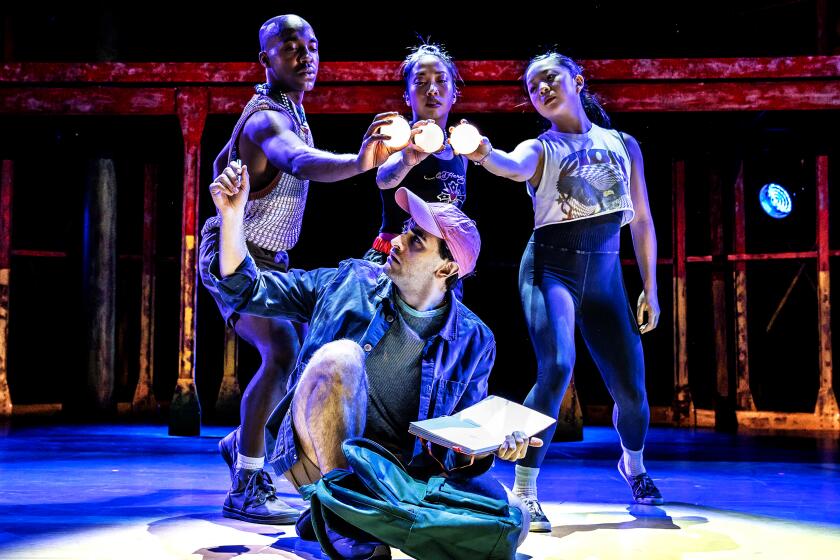25,200 Visions of Los Angeles, Past and Present
L.A. and laser discs would seem to go together: fast, frenetic, fanciful, slow, meandering, multidimensional, confusing, exhilarating. All that describes the city and also characterizes “L.A. Journal, Vol. 1” ($25), the Voyager’s Co.’s busiest, shortest, longest and most free-form laser disc yet.
Released this week on an eight-inch disc, the album produced by Mark C. Brems features 25,200 frames that can be viewed in a whooshing 14 minutes, or can be seen one frame at a time taking advantage of the laser disc player’s ability to let you focus on the images in scan, play, step, slow-mo and other standard (CAV) modes.
The little disc also offers three soundtracks: a digital track featuring a frenetic original stereo score by contemporary composer Carl Stone; an analog track with often bizarre spoken-word performances from 14 area poets-performers, and another analog track featuring archival Los Angeles music, from Cahuilla Indians to William Grant Still.
The images, whether from archival photos and postcards or contemporary scenes, have all been captured by a special photographic process dubbed “animated photojournalism” developed for this disc. All was shot by a Nikon modified to act like a 35-millimeter motion-picture camera as well as a still camera. It was held sidewise, with motion-picture film stock advancing vertically, one shot at a time, or at a maximum of three frames per second.
It’s not surprising that this disc took six years to make, although Brems, who did the photography, had to fit it in among other tasks for Voyager.
The pictures, listed on a table of images, fall within 16 topics, each of which is divided into subcategories. Topics include architecture, “art inside and out,” museums, media, gardens and parks, people and politics, neighborhoods, museums and sports.
Both Los Angeles natives and more recent immigrants might find some of the most fascinating “footage” in images from UCLA’s postcard collection of the young city where folks went to East Lake, West Lake, the Ostrich and Alligator Farms. Among snaps of interest are photographs of Van Nuys, Malibu Colony and Beverly Hills houses, downtown now and then and “overviews” that include vistas of and from the Hollywood sign and Universal City. Some might even want to focus on the Los Angeles Times and The Times’ collection of photos from its very early days to the present, or urban photos from the Pacific Electric collection, or motion picture clips from Mt. Lowe.
Viewed one frame at a time, it is an overwhelming collection of the city’s history in photographs. Seeing the images flashing by in “real time” with any one of the three audio tracks going full blast is an unsettling experience. The digital music or the poetry and comments or the folk music have nothing whatsoever to do with the images that flash by. They are either annoying or confusing depending on your point of view. What, in effect, the disc offers is four separate experiences: the images, the rapid-fire music, the commentary or the historical folk music. Separately they may be interesting, but thrown together at regular speed, they make up an electronic hodgepodge.
Depending on your interest and time you can find among the 25,200 frames of film material that will fascinate or bore you. It remains to be seen whether this new use of the technology catches on, but you cannot watch it without some hands-on--interactive--involvement.
*
Several recent laser releases offer a look at Peter Sellers beyond his most well-known roles as the bumbling Inspector Clouseau in half a dozen “Pink Panther” films, or the man-child of “Being There” or as “Dr. Strangelove.” Sellers’ other films range widely in quality, but all show off his particular brand of comedy even in his mediocre performances.
Blake Edwards’ 1968 “The Party” (MGM/UA Home Video, $35) is part of a long line of Edwards’ films skewering Hollywood. It’s uneven but filled with amusing, if dated, set pieces. Also from 1968 is “I Love You, Alice B. Toklas” (Warner Home Video, $35). Written by Paul Mazursky and Larry Tucker, it tries to paint a portrait of the free-love ‘60s with varying degrees of success. Some consider it a cult classic.
“The World of Henry Orient” (1964), a letterboxed MGM/UA release ($35), focuses less on Sellers than on two adolescents, but gives him a playing field that shows off his antic side, written by Nora Johnson and her father, Nunnally Johnson, and directed by George Roy Hill. It’s the best of the lot.
The 1967 “The Bobo,” presented in widescreen by Warner Home Video ($35), offers Sellers as a singing matador. Clouseau this isn’t.
Unfortunately, neither is his last and least film, 1980’s “The Fiendish Plot of Dr. Fu Manchu,” which does have Helen Mirren to offer but little else (Warner Home Video, widescreen, $35).
New Movies Just Out
“Malcolm X” (Warner, $40); “The Bodyguard” (Warner, $40); “Love Field” (Orion, $40); “Lorenzo’s Oil” (MCA/Universal, $40); “Home Alone 2: Lost in New York” (FoxVideo, widescreen, $30); “Teenage Mutant Ninja Turtles III” (Image, $35); “1492: Conquest of Paradise” (Paramount, $40), “Nowhere to Run” (Columbia TriStar, $35).
Coming Soon
MCA/Universal’s “Scent of a Woman” is due next week, in widescreen at $40, along with the Richard Gere romance “Sommersby” (Warner, $35). MCA/Universal’s “Mad Dog and Glory,” starring Robert De Niro and Bill Murray, is scheduled for Aug. 25, in widescreen at $35. The Bill Murray comedy “Groundhog Day” comes out the same day, from Columbia TriStar at $35.
More to Read
The biggest entertainment stories
Get our big stories about Hollywood, film, television, music, arts, culture and more right in your inbox as soon as they publish.
You may occasionally receive promotional content from the Los Angeles Times.





